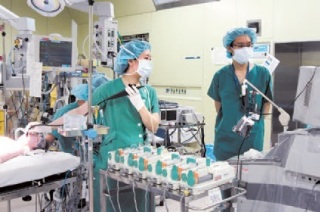Centers & Services
Top > Centers & Services > Clinical Services > Anesthesiology and Pain Relief Center
Anesthesiology and Pain Relief Center

The Anesthesiology and Pain Relief Center provides peri-operative anesthetic management for patients undergoing surgical treatment at the Central Surgical Center and pain management for outpatients and inpatients at the Pain Relief Center.
Medical services
In the operating room, each patient’s medical aspect is comprehensively managed by an anesthetic team that consists of board-certified anesthesists and medical interns. In the intensive care unit (ICU), each patient’s medical aspect is monitored by an ICU team that consists of board-certified anesthesists and senior residents. At the outpatient clinic and inpatient ward, a team of one or two pain physicians and one resident provides medical care.
Diagnosis and treatment policy
- The highest priority is always placed on ensuring patients’ safety in the management of surgical anesthesia. For patients who have serious preoperative comorbidities, we hold an outpatient booth for extended evaluation and case review meeting for discussion with surgeons.
- The goal of pain management is not only pain relief but also improvements of ADL and QOL.
Specialties
Perioperative Management
We cover a variety of diseases requiring surgical treatment. Our department is staffed with highly skilled anesthesiologists.
Pain Relief Center
We focus the biopsychosocial model of pain and promote adequate use of several lines of analgesics including opioids. In close cooperation with other departments, we evaluate physical and psychological conditions of patients with pain. Our interdisciplinary approach synergistically promotes to achieve high-quality pain management.
Target diseases
Perioperative Management
All diseases treated surgically, and any comorbidities of the patient.
Pain Relief Center
Neuropathic pain (post-herpetic neuralgia, diabetic polyneuropathy, spinal pain syndrome, brachial plexus injury, phantom limb pain, thalamic pain, etc); Nociceptive/Inflammatory pain (low back pain, osteoarthritis, peripheral vascular diseases, etc); Cancer pain; pain by cancer treatments; facial myokymia, etc.
Advanced treatments/ Specialized treatments
The following therapies for pain relief are available:
Spinal cord stimulation
By inserting electrodes into the epdidural space and stimulating the spinal cord, the SCS achieves pain relief, amelioration of spasticity subsequent to nerve injury and improvement of peripheral circulation.
Exercise treatment
Painful and degenerative syndromes of the musculoskeletal system are treated by the exercise treatment, which can prevent pain and degeneration of the system.
Cognitive-Behavioral therapy
Educating coping strategy and correcting behavioral patterns can result in recovery of meaningful life
Botulism injection
Botulism injection improves the facial myokymia, the cervical dystonia, and other spastic disorders.
Frequently performed tests
Perioperative Management
Standard monitoring, including electrocardiography, percutaneous oxygen saturation, and blood pressure measurement, is basically performed during and after surgical anesthesia. In addition, central intravenous catheter, pulmonary arterial catheter, transesophageal echocardiography, and cerebral oxygen saturation monitoring can be performed according to the invasiveness of the surgery and the patients’ condition.
Pain Relief Center
We perform multi-faceted evaluations on pain including nature of pain, health literacy, pain catastrophizing, neuropathic pain screening, personality inventory, psycho-psychiatric assessment, etc).
Kanji Uchida
Departments/Divisions
Anesthesiology and Pain Relief Center, Department of Unapproved New Drugs and Medical Devices Evaluation
Titles
M.D., Ph.D.
Expertise/Specialties
Anesthesiology, Critical care medicine, Respiratory care, Operative medicine, Pain medicine
Research Interests
Acute lung injury, Mechanical ventilation, Immune function in critically ill, Mechanism of general anesthesia, Modulation of pain
Languages
Japanese / English
Neuropathic pain
We provide approaches to prevent pain-related decreases in ADL and the QOL, using appropriate pharmacotherapy in combination with other treatment methods, such as cognitive behavioral therapy.
Diseases treated in this department include: postherpetic neuralgia; pain after spinal cord injury; cervical myelopathy; pain after brachial plexus injury; phantom limb pain; diabetic neuropathy; disc herniation; pain syndrome after spinal surgery; lumbar spinal canal stenosis; complex regional pain syndrome (CRPS) [reflex sympathetic dystrophy syndrome (RSD) and causalgia]; ossification of the spinal ligaments; trigeminal neuralgia; glossopharyngeal neuralgia; intercostal neuralgia; and pain after thoracotomy.
Pain during cancer treatment
We support cancer treatment by effectively managing diverse types of treatment-related pain (such as chemotherapy-related neuropathy and postoperative pain).
> Cancer-related pain
We manage pain during the advanced cancer stages mainly using narcotic analgesics in cooperation with the Department of Palliative Care.Nerve block is applied accordingly.
Ischemic pain due to peripheral vascular disorders
We aim to conserve affected limbs and avoid amputation as much as possible by performing effective approaches, such as pharmaco-, spinal cord stimulation, and nerve block therapies. Diseases treated with these approaches include: Buerger's disease; and antiphospholipid antibody syndrome.
Musculoskeletal pain
We also treat musculoskeletal pain, such as low back and joint pain and stiff shoulders. Preventive approaches, such as appropriate therapeutic exercises and obesity treatment, are also focused on. Diseases treated with these approaches include: low back pain; cervical disease; hip and knee osteoarthritis; stiff shoulders; periarthritis (frozen shoulders); and traumatic neck syndrome (whiplash).
Headaches
Such as migraine, cluster headache, tension-type headache, temporal arteritis, atypical facial pain, sphenopalatine neuralgia, and sore tongue.
Diseases treated in this department, other than pain
Such as facial nerve paralysis (Bell's palsy), Hunt syndrome, ophthalmoplegia syndrome, facial spasm, psychosomatic disorders, spasmodic torticollis, and chronic fatigue syndrome.
Major diseases treated in this department and numbers of in- and outpatients (including duplicated diagnoses)
| Disease name | Number of new outpatients | Number of inpatients |
|---|
| 1 | Spinal, musculoskeletal system | 163 | 49 |
| 2 | Varicella zoster related | 30 | 26 |
| 3 | Other nerve pains (pain associated with spinal cord injury, phantom limb pain, thalamic pain syndrome) | 51 | 22 |
| 4 | Cancer Pain Management | 20 | 3 |
| 5 | Pediatric Pain Management | 4 | 0 |
(2015)

